Principal Investigator: Matthew Nonnenmann, PhD
Research Team: T. Renée Anthony, Thomas Peters, Jenna Gibbs, Ralph Altmaier, Alejandro Ramirez (ISU)
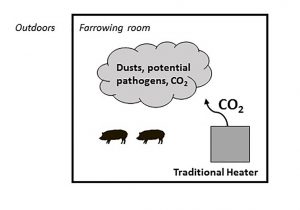
Traditional Farrowing Room
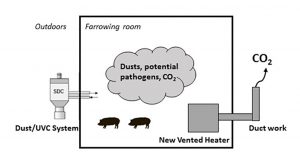
Study Farrowing Room
Project Goals and Aims
The goals of the project were to develop, deploy and evaluate a large, filtration-based recirculating ventilation system (RVS) that uses UVC to reduce dust and bioaerosol in commercial swine
production,
- Aim 1 of the project resulted in the development of trailer-based RVS (tRVS) that was scaled for commercial swine production (Figure 1) that was deployed outside of production buildings, minimizing the impact on production as we tested this technology.
- Aim 2 resulted in the development and evaluation of a UVC plenum to enclose in the tRVS that inactivated bioaerosol at targeted airflow rates (e.g., 1600 cfm).
- Aim 3 evaluated the effect of tRVS use on dust and bioaerosol concentrations in commercial swine production.
Why is this Research Important?
This work broadens previous studies by designing and evaluating the tRVS for commercial operations. Our rationale is that effectively translating research findings about RVS effectiveness, costs, and cost-savings to stakeholders will lead to adoption, and concurrently improve worker and animal health in the swine industry.
Major Activities
The research team conducted testing of the prototype air filtration system deployed in a single farrowing room at a swine production operation (Dec 2017-Feb 2018). In the current reporting period, we have analyzed the data to evaluate the effectiveness of the system.
- When operating at 45 m3/min (the target 5 ACH), mean inhalable and respirable dust concentrations observed during the
study period for the “treatment” room were 2.61 and 0.14 mg/m3, respectively, compared to 3.51 and 0.25 mg/m3, respectively, for the control room. We observed no concentration differences in ammonia and relative humidity between the treatment and the control rooms. Inhalable and respirable concentrations of dust were significantly reduced (25%, 48%, respectively; p≤0.04), which demonstrates 5 ACH was effective to control dust in commercial farrowing. - In winters of 2020 and 2021, the system was located at an educational site (because of producer restrictions regionally due to African Swine Fever risks), and this time deployed in finishing using the same 5 ACH as was designed for farrowing. We failed to observe a difference in dust concentrations across the treatment and control rooms for this experiment. The hog density was significantly higher (28%) in the treatment room across these tests, and higher dust concentrations resulted in non-significant reductions in the treatment room compared to farrowing studies: these findings may suggest that 5 ACH may not be a high enough air treatment rate to overcome the dust generation rate in swine
finishing. - Disinfection studies in the lab were needed to (1) develop aerosolization process using target microorganisms (i.e., MS2 and E. coli), (2) develop methods to assess viable organisms in sampling method, and (3) optimize UVC dose for aerosol disinfection. Most relevant to the progress of the technology, the optimized doses were found for E. coli (6-log reduction at 1.09 mJ/cm2 = 1 UVC bulb) and for the more resistant MS2 (6.4-log reduction at 35.5 mJ/cm2 = 26 UVC bulbs).
- Bioaerosol studies in the finishing barn using the SKC Biostage sampler and three nutrient agars (tryptic soy, eosin methylene blue, and mannitol salt) identified: 1.2 log reduction in total bacteria and staphylococcus and nearly complete control of E. coli in air that passed through the treatment system. Room concentrations of bioaerosol were significantly lower for the treatment room for both total bacterial and E. coli bacteria, but staphylococcus bioaerosol was not significantly reduced.
Going Forward
While the tRVS has been advanced to include disinfection technology, the next phase of studies requires a transformative advancement to reduce cost and the footprint of the control technology. We plan to further optimize the system to target specific human and pig pathogens (e.g., influenza virus) by designing in-room units that filter and inactivate bioaerosols. Future work will incorporate input from a swine industry stakeholder advisory group, developed out of partnerships with producers.
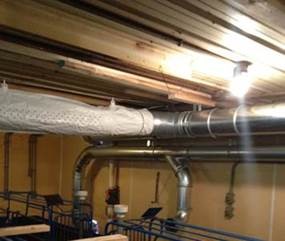
Newly installed duct work handling air in a farrowing barn.
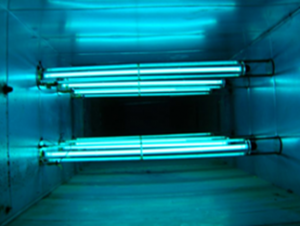
UVC treatment in duct work. UVC has been used successfully in other biosecurity applications.
In the News
- “Influenza in the air . . . . what’s new?” M. Torremorell. National Hog Farmer (Dec 23rd, 2016).
- “Your minimum ventilation rate may be wrong” Industry Voice by Hog Slat. National Hog Farmer (Dec 16th, 2016).
Timeline
- Year 1: Perform baseline monitoring for dusts, bioaerosols, and gases.
- Years 2-3: Install and test new technology (at no cost to the producer) in 3 of 4 farrowing rooms.
- Years 4-5: Modify and test the new technology based on laboratory findings on ability to remove viruses and bacteria.
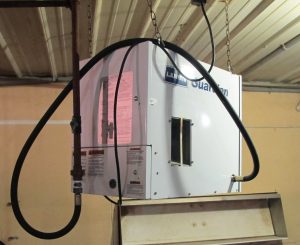
Traditional Heater
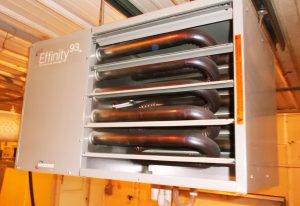
New Heater
Posters Summarizing Results
Baseline results at intervention facility: 2016-17 Baseline Study
Preliminary Studies
See the summary of the preliminary studies for this project here.
One-pager from 2016-22 GPCAH Evaluation Report
See brief one-page summary of the project’s impact here.
Last updated 01/13/25
